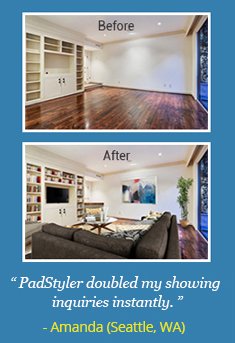Are you still marketing real estate in the classified section of your local newspaper? Probably not because like most realtors, you now use a range of online marketing resources.
Today instead of blurry, grainy images, you can showcase your listings with sharp, detailed images.
But wait, what about those challenging properties—the vacant, the worn out, and the ones with tenants living in them? The homes all agents wonder how they’ll ever encourage buyers to look at.
The answer is digital staging.
While it’s not a new technology, it’s grown up over the last few years. If you’ve not considered virtual staging solutions for the homes you’re listing, this post is for you. It’s also for agents who aren’t quite sure how it works and if it’s worth it.

Read our short guide and look at real estate through a different set of lenses.
It Is All About the Software
Digital staging relies on specialized software. Yes, photo quality matters because the higher quality the image, the more you give the software to work with. But the end result comes from the perfect pairing of the skilled virtual designers and the software.
In short, virtual staging software uses 3D technology. The software inserts furnishing and accessories into photos of vacant properties. Empty rooms work best but the virtual interior designer can work around existing furnishings.
A skilled virtual interior design specialist knows how to make even the ugliest room appealing to buyers. Real estate agents love it because if they have homes they know could appeal to more than one buyer profile, they can use more than one staging package.
Let’s dive a bit further into how virtual staging works.
Digital Staging Is Like Magic
On the realtor side, digital staging begins with an image. Either the realtor or the real estate photographer shoots a set of high-quality images of the home.
Of course, the best option is to shoot photos of totally vacant rooms but as we mentioned earlier, it’s also fine to take images of rooms with furniture if necessary. The renderer or virtual designer can remove anything in the room—digitally.

Once the realtor submits the images, there’s nothing left for them to do but wait. The virtual designer then takes over and creates a virtual masterpiece.
The realtor receives an email with the finished photos attached for their approval. All images are ready for MLS posting or on the realtor’s website. It really is magic and the realtor doesn’t do much other than provide the images.
Now that you see how simple the process is from the realtor’s end, you’re curious how virtual staging can benefit you and your clients, correct?
Benefits of Virtual Home Staging
You’ve already seen one benefit—less time and less energy spent creating images for your listings. You’ll enjoy multiple benefits when you decide to go digital. Here are a few:
Excited Buyers
Most buyers have a hard time seeing themselves in the homes they view. Virtual staging helps you show prospective buyers what their life might look (and feel) like in the home you’re listing.
Target Marketing
Many of the homes you list could appeal to multiple buyer demographics if you could customize the space and tailor it to the preferences of each demographic. No problem with your virtual designer! They’ll design the room however you want it designed.

Less Time and Less Effort
Earlier we mentioned the time savings you can enjoy by using virtual staging. It saves time because all you do is shoot the photos and the virtual designer does the rest. You’ll also save time and money because you’re not paying a staging company, or staging homes using your resources.
Less Time on the Market
Because digital staging helps you make your listings appeal to a specific demographic, your listings may sell more quickly. When the right buyers see your home before they waste time elsewhere, it can mean a fast (and attractive) offer.
It’s an attractive benefits package but does it work for every listing?
When Not to Use Virtual Staging
While virtual staging is the ideal solution for many homes, it’s not always perfect for every listing.
The best time to use the technology is when you’re selling a vacant home, one with outdated décor, or one occupied by tenants. These are all situations where the homeowner has little to no control over the presentation of their home.
If your seller already has a pristine showcase of a home, consider traditional staging.
Even in the most beautiful home, however, there are usually one or two rooms that could use touching up. In those cases, use virtual staging for only those spaces.

What Will My Clients Think?
If you’ve not used digital staging, you may feel apprehensive, especially when working with clients who may not understand how the technology works. It makes sense but if you look at the growing popularity of virtual real estate staging, it seems like buyers and sellers see its value.
One thing you must do is make sure buyers know when you’ve virtually staged a property.
It’s easy to include a disclosure on the MLS site and your real estate agency site. If you do that, you won’t shock a prospective buyer when they visit a vacant home after seeing your spectacular listing.
Ready to Begin Your New Virtual Adventure?
We hope you’ve enjoyed this guide and will take away some of the highlights of using virtual staging.

It’s an excellent tool for realtors who want to not only increase sales, but also to join the growing movement toward using technology to buy and sell homes.
If you’re ready to use digital staging, or you have more questions on the technology, contact us today. We’re here to help you!




